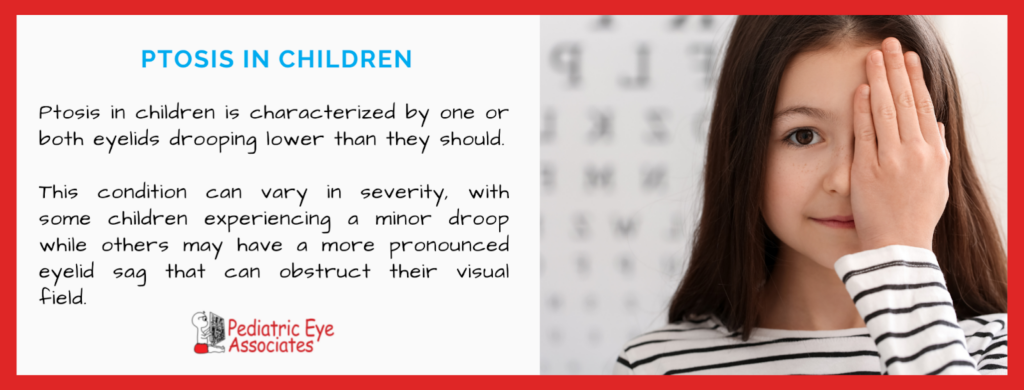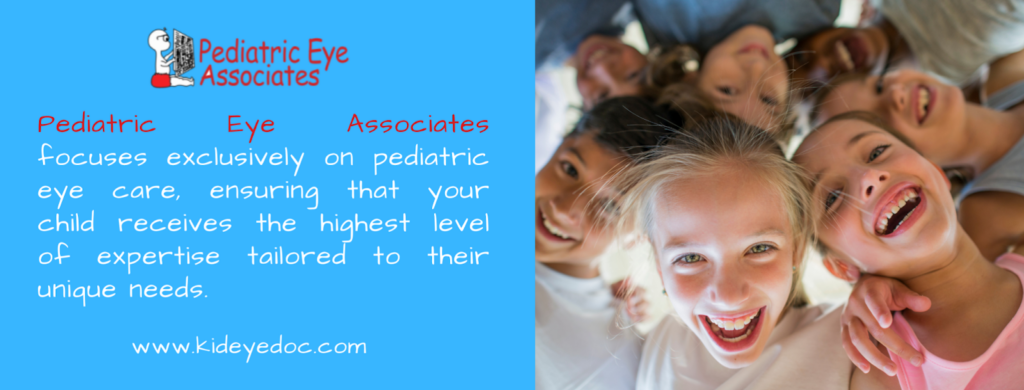Ptosis, commonly known as “droopy eyelid,” is a condition that affects individuals of all ages. However, when it occurs in children, it can be a source of concern for parents and caregivers.

In this comprehensive guide, we’ll explore the various aspects of ptosis in children, including its causes, symptoms, and available treatment options.
What is ptosis in children?
Ptosis in children is characterized by one or both eyelids drooping lower than they should. This condition can vary in severity, with some children experiencing a minor droop while others may have a more pronounced eyelid sag that can obstruct their visual field.
If left untreated, ptosis can significantly impact a child’s vision and eye health. It can lead to different visual issues, such as amblyopia or lazy eye, delayed visual development, and even irreversible visual impairment.
What are the main causes of ptosis?
Ptosis in children, particularly congenital ptosis (present from birth), can have various underlying causes. These are as follows:
Congenital ptosis
One of the primary causes of ptosis in children is congenital ptosis, which means the condition is present from birth. There are two reasons why ptosis can be present at birth:
- Children may inherit ptosis if one or both parents have it in their genes.
- An underdeveloped or weak eyelid (levator) muscle causes difficulty in lifting the eyelid.
Congenital ptosis can affect one or both eyes.
Neurological condition
Some children may develop ptosis as a result of neurological conditions, such as Horner’s syndrome or third nerve palsy. These conditions can disrupt the normal functioning of the eye muscles, leading to drooping eyelids.
Other conditions and abnormalities
Inflammatory conditions, infections, or neuromuscular disorders affecting the eyelid or eye muscles can lead to temporary ptosis in children. This is often referred to as acquired ptosis.
Additionally, some congenital abnormalities or syndromes are associated with ptosis as one of their features. Some examples include blepharophimosis syndrome or Marcus Gunn jaw-winking syndrome.
What are the symptoms of ptosis in children?

Identifying ptosis in children is crucial for early intervention. Here are the telltale signs of droopy eyelids:
- Drooping eyelid: One or both eyelids may appear lower than they should, partially covering the eye.
- Uneven eye appearance: One eye may appear smaller or more closed than the other.
- Excessive blinking or squinting: This can be an unconscious effort to improve their vision by reducing the obstruction caused by the drooping eyelid.
- Tilting the head backward or lifting the chin: This head posture is often an instinctive response to the limited field of vision caused by ptosis.
- Difficulty with activities: Children with ptosis may experience difficulty with activities that require clear vision, such as reading, writing, or participating in sports.
- Amblyopia or lazy eye: the brain starts to favor one eye over the other due to differences in visual input.
- Headaches: These are often the result of head tilting and straining the eyes.
If you observe one or more of these symptoms in your child, it’s essential to seek a professional evaluation by a pediatric eye doctor.
How is ptosis diagnosed?
Diagnosing ptosis in children typically involves a thorough eye examination by a pediatric optometrist or ophthalmologist. The evaluation may include:
- A detailed medical history to identify any underlying conditions.
- Measurement of the degree of ptosis.
- Assessment of eye movement and alignment.
- Visual acuity tests to determine any impact on vision.
Once the diagnosis is confirmed and the underlying cause is determined, your child’s eye doctor will develop an appropriate treatment plan.
Treatment options for pediatric ptosis can include surgical correction, non-surgical approaches, or a combination of both, depending on the case.
What are the treatment options for ptosis in children?
Fortunately, several treatment options are available for children with ptosis, depending on the underlying cause and the severity of the condition.
1. Non-surgical approaches
In mild cases of ptosis or when surgery is not immediately required, non-surgical approaches can be explored. These may include:
- Patch therapy
In some cases, patching the stronger eye can encourage the weaker eye to work harder, potentially improving muscle strength.
- Glasses
If the ptosis is causing unequal refractive error (hyperopia or myopia or astigmatism), glasses may be prescribed for your child.
2. Surgical correction
Surgical intervention is sometimes the most effective treatment for moderate to severe ptosis in children. Ptosis repair is typically performed under general anesthesia.
The timing of surgery varies depending on the individual case, but it is often considered when the child is around 3 to 5 years old, once the eyelid and eye muscles have developed sufficiently.
Pediatric ptosis surgery is generally safe, with a high success rate. It can significantly improve both the appearance and function of the eyelid.
3. Post-surgery care and follow-up
After ptosis surgery, it’s essential to follow the post-operative care instructions provided by the surgeon. This may include using prescribed eye drops or ointments, keeping the surgical area clean, and attending follow-up appointments to monitor progress and address any concerns.
4. Visual rehabilitation
In cases where ptosis has led to amblyopia (lazy eye) or other vision-related issues, visual rehabilitation may be necessary. This can include glasses, patching, or other treatments to improve vision in the affected eye.
Schedule your child’s eye appointment today
At Pediatric Eye Associates, we focus exclusively on pediatric eye care, ensuring that your child receives the highest level of expertise tailored to their unique needs.
Our team of skilled pediatric ophthalmologists and optometrists has years of experience diagnosing and treating a wide range of eye conditions in children, such as ptosis.

Pediatric Eye Associates believes that every child deserves exceptional eye care to support their growth, development, and well-being.
So, contact us now to ensure a bright and clear future for your little one!
The material contained on this site is for informational purposes only and DOES NOT CONSTITUTE THE PROVIDING OF MEDICAL ADVICE, and is not intended to be a substitute for independent professional medical judgment, advice, diagnosis, or treatment. Always seek the advice of your physician or other qualified healthcare providers with any questions or concerns you may have regarding your health.
